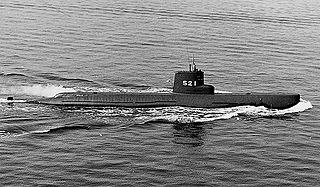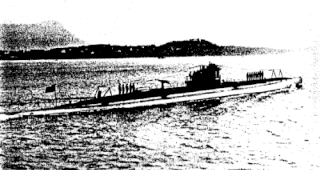
The Delfinen-class submarines were the first class of submarines constructed for the Royal Danish Navy following World War II. They were designed and built within Denmark, with first three boats of the class financed by Denmark. The fourth was financed by the United States under the Cost Share program. Constructed between 1956 and 1963, the class comprising four submarines entered service in 1961 and the last taken out of service in 1990. Replaced by the Norwegian Kobben class, three of them were scrapped while a fourth was converted into a museum ship and remains on display at the Aalborg Maritime Museum.

The Hayashio-class submarine was the successor design to the Japanese submarine Oyashio, and the predecessor of the Natsushio class with the Japan Maritime Self-Defense Force. Ordered in 1959, the boats were small with limited capability but were successful. Constructed in Japan from 1960 to 1962, they remained in service until 1979 when they were discarded.

Ajax was a Redoutable-class submarine of the French Navy launched in 1930 at Brest, France. It participated in the Second World War, first on the side of the Allies from 1939 to 1940 then on the side of the Axis for the rest of the war. On 23 September 1940, during the Battle of Dakar she was badly damaged by depth charges from HMS Fortune (H70) and was then scuttled.

The Requin-class submarines were a class of nine diesel-electric attack submarines built for the French Navy in the mid-1920s. Most saw action during World War II for the Vichy French Navy or the Free French Naval Forces. Nine ships of this type were built in the shipyards of Brest, Cherbourg and Toulon between 1923 and 1928. The class was part of the French Marine Nationale, serving in the Mediterranean Sea. All member ships took part in World War II, fighting on both sides of the conflict; Four were captured by Italian forces and sunk by the Allies. Only one ship survived the war - Marsouin, decommissioned shortly after the war's end.

The French submarine Caïman was a Requin-class submarine built for the French Navy in the mid-1920s. Laid down in August 1924, it was launched in March 1927 and commissioned in February 1928. On 9 June, Caïman narrowly missed the British light cruiser HMS Ajax off Syria. It was scuttled at Toulon on 27 November 1942 to prevent her capture by the Germans, then raised in February 1943. It was sunk again on 11 March 1944 by Allied aircraft.

The French submarine Espadon was a Requin-class submarine built for the French Navy in the mid-1920s. Laid down in October 1923, it was launched in May 1926 and commissioned in December 1927. It was disarmed at Bizerte, Tunisia in April 1941 and captured there by Italian forces on 8 December 1942 and renamed FR 114. It was scuttled by the Italians at the Castellamare shipyard on 13 September 1943, then raised by the Germans in 1943 but not repaired.

The Aigrette-class submarines were a class of two submarines built for the French Navy between 1903 and 1905. They were essentially experimental submarines, and although in service during World War I, saw no action. The class was designed by Maxime Laubeuf and used Drzewiecki drop collar launchers and external cradles to launch torpedoes.

Cigogne was the second of two Aigrette-class submarines built for the French Navy between 1903 and 1905. Laid down in May 1902, she was launched in November 1904 and commissioned in July 1906. She was an essentially experimental submarine, and although in service during World War I, saw no action. The class was designed by Maxime Laubeuf and used Drzewiecki drop collar launchers and external cradles to launch torpedoes.

The Lagrange-class submarines were a class of four submarines built for the French Navy during World War I and the interwar period. Three ships of this type were built in the Arsenal de Toulon from 1913 to 1924, and one was built at the Arsenal de Rochefort shipyard. Entering the French Marine Nationale from 1918 to 1924, the submarines served until the mid-1930s.

The French submarine Laplace (Q111) was a Lagrange-class submarine built for the French Navy built between 1913 and 1919. It was laid down in the Arsenal de Rochefort shipyards and launched on 12 August 1919. Laplace was completed in 1921 and served in the French Marine Nationale until 1935.

The French submarine Lagrange (Q112) was a Lagrange-class submarine built for the French Navy built between 1913 and 1918. It was laid down in the Arsenal de Toulon shipyards and launched on August 12, 1919. Lagrange was completed in 1918 but saw no action during World War I and served in the French Marine Nationale until 1935.

The French submarine Regnault (Q113) was a Lagrange-class submarine built for the French Navy built between 1913 and 1924. It was laid down in the Arsenal de Toulon shipyards and launched on June 25, 1924. Regnault was completed in 1924 and served in the French Marine Nationale until 1937.

The French submarine Romazotti (Q114) was a Lagrange-class submarine built for the French Navy built between 1914 and 1918, during World War I. It was laid down in the Arsenal de Toulon shipyards and launched on March 31, 1918. Romazotti was completed in 1918 and served in the French Marine Nationale until 1937.

The Joessel-class submarines were a class of two diesel-electric submarines built for the French Navy laid down before the start of World War I and completed after. They were built in the Arsenal de Cherbourg from 1913 to 1920, before entering the French Marine Nationale in 1920 and serving until 1936.

The French submarine Joessel was a Joessel-class diesel-electric attack submarine built for the French Navy between 1913 and 1919. Joessel was built in the Arsenal de Cherbourg from 1913 to 1917, entered the French Marine Nationale in February 1920 and served until 1936.

The French submarine Fulton was a Joessel-class diesel-electric attack submarine built for the French Navy between 1913 and 1919. Fulton was built in the Arsenal de Cherbourg from 1913 to 1920, entered the French Marine Nationale in July 1920 and served until May 1936.

The Armide-class submarines were a class of three diesel-electric submarines built for the Greek and Japanese Navies before and during World War I. They were built in the Schneider-Creusot shipyards 1913 to 1918, but were seized during the war by the French government before they could be sold. The Armide class ships operated in the Mediterranean during the course of World War I and were stricken from the Navy list between 1928 and 1935.

Armide was a submarine ordered by the Japanese Navy from the Schneider-Creusot shipyard before World War I but was requisitioned by the French government before it was launched. Armide operated in the Mediterranean during the course of World War I and was stricken from the Navy list in July 1932.

The French submarine Antigone was an Armide-class diesel-electric attack submarine originally ordered by Greece. It was built in the Schneider-Creusot shipyards between 1912 and 1917, but was requisitioned on 30 May 1917 by the French Government before it was delivered. Antigone operated in the Mediterranean during the course of World War I and was stricken from the Navy list in August 1935.

The French submarine Argonaute was an experimental attack submarine built for the French Navy between 1903 and 1911. Initially named Omega, Argonaute was laid down in January 1903, launched in November 1905 and commissioned in 1911. She was essentially an experimental submarine, and although in service during World War I, saw no action. Argonaute was decommissioned in 1919.















